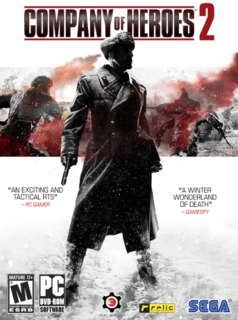INTRO:
The base package of Company of Heroes 2 was not exactly well-received by a lot of people. One of the complaints was that the campaign in that base package was not as epic as the developers like to think it is. In particular, the story that it is telling is little more than narrative glue that Relic hoped would somehow tie the disparate missions together.
Since then, Relic has mainly focused on the non-campaign parts of the gameplay; there have been a few expansion packs, which introduce factions that are based on the armies that fought on the Western Front of the European theatre.
Yet, without telling a story that pays homage to the setting of World War 2 (WW2), Company of Heroes 2 is not going to do much to re-engage players who wanted such an adaptation of those war stories, much less engage new players. Furthermore, during its time, it had to compete with contemporaries like the Men of War and Sudden Strike games.
Thus, Relic made an expansion pack about a campaign that is based on the Battle of the Bulge.
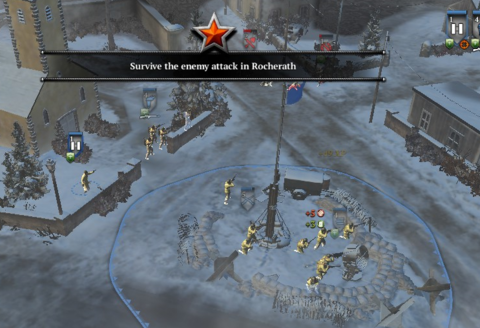
PREMISE:
The Battle of the Bulge was a particularly dramatic chapter in WW2. The Ardennes expanse was thought to be relatively safe for fatigued combat units of the US forces to rest and rearm.
However, this was not to be the case; the Western German army committed a sizable force that took the resting Allied forces – who are mostly USA troops – by surprise. By the time that the Allied forces organized a functional resistance, the Germans have already driven deep into the Ardennes and cut off a lot of combat units from each other.
Yet, it became apparent that the Germans had planned for what would have been an overwhelming attack that should have resulted in swift victory. This was not to be the case either.
The success that the Allies had at regrouping and counter-attacking was attributed to the grit of the soldiers that survived, and the Germans’ lack of long-term strategies. The player gets to experience an adaptation of that story in the expansion pack.
REPACKAGED USA FORCES:
Firstly, it should be mentioned that although the protagonists are American forces, they are not straight copies of the ones seen in the Western Front expansion pack. Rather, they are repackaged sub-factions, with their designs being (loosely) based on the USA companies that fought in the Battle of the Bulge.
As such, players who have played with the factions that the Western Front expansion has implemented might find some of the units and base-building to be familiar. Some of the gameplay designs will be mentioned in this article where pertinent.
COMPANIES:
The protagonists of the campaign are three USA companies of differing capabilities; if the player has the Western Front expansion, there would be four companies. Either way, the player only gets to pick three companies. Regardless of their depiction, the four companies are fictional, even if they may have elements that relate them to the real USA companies that fought in the Battle of the Bulge.
Anyway, there is Able Company. It is a repackaging of the Airborne Company sub-faction of the US Forces. The player would be relying on Paratroopers more often than not, if only because they are likely to be the largest and most capable infantry squads for that company. Airstrikes would also be a major part of the player’s tactics, though these do consume precious munitions.
Then, there is Baker Company, which is a repackaging of the Mechanized Infantry company. The US Forces faction has a problem with the replenishment of depleted infantry teams, because half-track transports are not standard-issue to the US Forces – except the Mechanized Infantry company. In this campaign, the transports are likely to be guaranteed inclusions in the player’s force when playing as Baker Company.
Next, there is Dog Company, which is a repackaging of the Tactical Support Company. The Assault Engineers of this company (which are also available to the Armor Company in Western Front) are likely to be the player’s most favoured units and called-in reinforcements, especially considering that they can be heavily and permanently upgraded.
Then, there is Fox Company, which is a repackaging of the Urban Assault Company. Rangers are likely to be the player’s most favoured units, mainly because they are among the most durable infantry in the game.
It should be noted that there are nine specializations for companies in the Western Front expansion pack; this campaign only features repackages of three. However, some of the special units and upgrade options that are associated with them are featured in this campaign, as part of the rewards for pursuing limited-time-only missions.
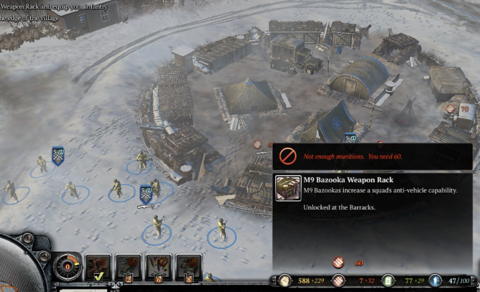
CAMPAIGN STRUCTURE:
The campaign in the base game can be criticized for trying to tie a bunch of disparate missions together with a clumsy narrative. Fortunately, the Battle of the Bulge provides a much tighter narrative for a campaign.
Interestingly though, instead of the usual succession of custom-made missions, there is a map that represents the Ardennes; the Ardennes is divided into more than a dozen sectors. The player’s end-goal is to remove the presence of all Third Reich forces from these sectors.
This might seem a lot like Warhammer 40K: Dark Crusade, which was a previous Relic-developed game. However, the player is the only one that is directing forces around.
That said, each sector has an enemy force that must be defeated in order to return the sector to Allied control. In turn, this force appears in a mission that is associated with that sector.
NARRATIVE MISSIONS:
Some of these missions are custom-made, having been adapted from after-action reports of the Battle of the Bulge. They may include objectives like preventing the Germans from stealing Allied supplies of fuel, taking bridges and roads that the Allies need to move wounded and supplies around, taking bridges and roads that the Germans need to move their own hardware around, and such other.
The main narrative-related reason to undertake these missions are the remarks and reports made by the commander of the company that the player chooses to spearhead the mission. There will be more on their voice-over performance later.
The other reason to undertake the missions is that there is a progression system that is applicable throughout the campaign. This will be described later too.
ENGAGEMENT SCENARIOS:
If the mission is not a narrative-driven mission, it would be one of the “engagement scenarios” instead. An engagement scenario has both sides – the player’s and the CPU-controlled enemy’s – being subjected to the same goal, unlike the narrative-driven missions.
For this purpose, the scenario utilizes meters that track the performance of the player’s forces and the enemy’s at pursuing the goal. Players who played the multiplayer match modes of Company of Heroes 2 may find these quite familiar.
The pursuit of the goal either fills the meters from zero to 250 points, or drains them from 250 points to zero. Getting or losing those points depends on the details of the goal. For example, there is a scenario that has one side draining the other side’s points by eliminating the other side’s units with vehicles, and only vehicles.
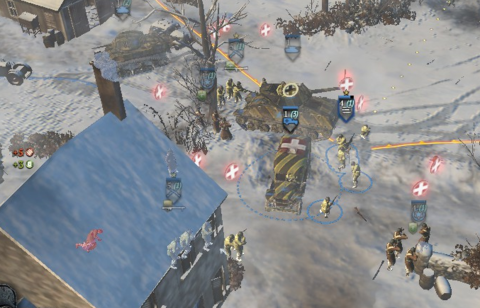
SOMEWHAT DECENT CPU ENEMY:
As to be expected of a single-player mode, the enemies are CPU-controlled and they are designed to be defeated. Having them pose a genuine challenge to the player is difficult, with this underlying design goal in mind.
The CPU-controlled enemies in this campaign are not incredibly skilled tacticians, but at least they are not as stupid as those in the campaign of the base game. They do know when to hold back their forces, though knowing when to commit them to an assault is another matter.
WINNING & LOSING:
Of course, the player wins a mission if the player manages to fulfil the stipulated goal. Winning does not mean that the player can just waltz onto the next mission, however; casualties taken during the course of the campaign do matter, as will be described later.
The player loses if the player fails the mission condition, of course. Alternatively, the player also loses if the player withdraws from the battle.
However, if the player chooses to quit the game instead, anything that the player has done for that mission is simply lost – which brings this article to a particularly important matter in this campaign.
ONLY ONE AUTO-SAVE:
For better or worse, the campaign in Ardennes Assault gives the player only one auto-save per playthrough. This auto-save updates whenever the player gets to the campaign map, and after the player does anything while still within that map. The auto-save also updates when the player saves and quit the game during a mission; this is the only way to resume a mission that is in progress. In other words, the campaign in this expansion pack is practically an “Iron Man” campaign.
COMPANY STRENGTH:
Having “Iron Man” limitations for a playthrough would not have been consequential, much less a challenge, if there is no long-term concern to be worried about. Fortunately, there is such a concern.
Each of the aforementioned companies has a statistic called “company strength”, which is represented as a meter. This is practically a “life-bar”; if this meter drains empty, the company is doomed and will be disbanded when the player returns to the campaign map. In other words, the player effectively loses one of the three forces that the player needs to wield in order to win the campaign.
If all three companies are disbanded, the player loses the campaign.
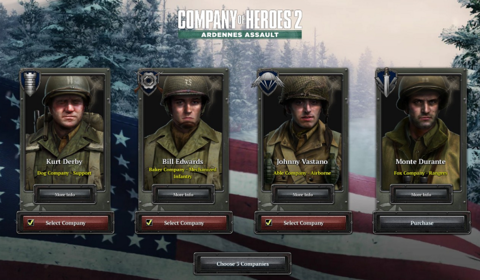
LOSING COMPANY STRENGTH:
Company strength is lost when a combat unit is wiped out. For a specific example, it is okay if an infantry squad is down to just one man; this will not affect company strength, even if the player replenishes the squad later. However, if that squad is wiped out, the game considers this as a casualty. Likewise, vehicles that are lost also count as casualties.
The strength that is deducted appears to be a portion of the population requirement of the unit, so losing powerful units will particularly drain strength. Therefore, the player will have to be very careful about preserving the units under one’s control. Knowing when to pull back will be particularly important, and pulling back units behind defensible positions is just as important.
(Conveniently, being a US Forces player, the player can build Fighting Positions throughout a map to really dig in. Losing these defensive buildings do not count as casualties.)
Unfortunately, there is another way to lose company strength and it is dependent on the player’s luck instead of skill. When moving a company about on the world map, the company may have an encounter that simply reduces the company’s strength; there is nothing that the player can do about this.
REGAINING STRENGTH:
A company that has not been used to carry out a mission will regain strength after the player has ended a mission, whether in success or failure. Amusingly, repeating losses by withdrawing from a mission can restore the strength of the other companies, though the company that withdraws repeatedly will take a bit of damage every time that happens. Moreover, the amount of strength regained is quite small with this method.
A company can also regain strength through the pursuit of certain secondary objectives. Secondary objectives are randomly generated for some missions, though with parameters that fits the main goals of the missions. Failing these secondary objectives does not harm the player, but success generally rewards the player with replenishment of company strength, specifically the strength of the company that is undertaking that mission. This happens immediately, by the way.
A company can also be reinforced with requisition to regain its strength, but this comes at a cost, which will be described later.
MOVING COMPANIES ACROSS CAMPAIGN MAP & TURNS:
In the campaign map, the player has to move icons that represent the companies across territories. A company can only be moved from one territory to an adjacent territory at any time. This also counts as a turn.
Turns generally do not matter much, unless there are additional mission rewards with limited windows of opportunity; there will be more on these later. That said, the player’s companies do not regain strength over turns. The German forces would not do much of anything either.
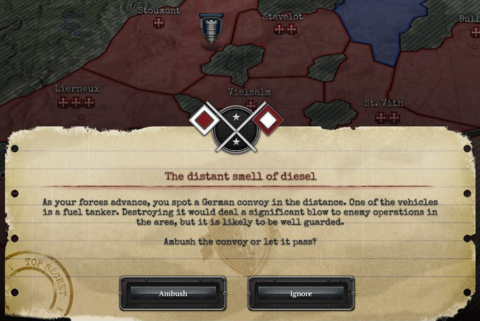
ENCOUNTERS:
When a company moves into any territory that does not have a mission, there is a chance that a random encounter can happen. For better or worse, this feature is as annoying as it is amusing.
As mentioned earlier, the encounter might be a wholly negative one: the player’s company takes damage to its strength, with no way to mitigate this. Alternatively, the encounter might be a beneficial one, e.g. survivors of depleted combat units join the company and strengthen it.
OPPORTUNITIES ADDITIONAL UNITS AND UPGRADES:
The most notable of these encounters is a notification of an opportunity to unlock more units and upgrade options, notably those that the company is not intended to have. For example, the player may be notified about the slated deployment of a Sherman Calliope squadron to a certain region of the Ardennes – typically one of the territories that is still occupied by the Germans. Winning the mission at this territory will yield the option to call in Sherman Calliopes in later missions.
Getting these unlocks can lead to amusingly overpowered combos. For example, being able to field Calliope Shermans and M7 Priests makes for formidable artillery barrages.
VETERANCY:
After the player has carried out a mission – whether it is successful or not – the player’s performance is measured according to the amount of experience points that the player’s units have accrued. Whether those units survive or not do not matter; the company will accumulate the points anyway.
As for how many points are gained, these are a portion of the experience points that the player’s units have gained; the equation that is used to calculate the exact amount is unclear.
Anyway, these points go into the veterancy bar of that company, which is represented with a meter that has yellow fill. When the meter is full, the company gains a rank, which is represented by stars.
The number of stars that the company has determines how many additional units that the player might have at the start of a mission. However, the composition of these units is randomized, so the player might get something that the player does not really need, such as a machinegun team for a map that does not have a lot of open spaces.
The number of stars also determines the experience level of a unit that has been called in; more stars means a more experienced unit. However, whether the unit has any experience from the get-go or not is a matter of luck; in other words, the fresh unit can be a rookie too. The number of stars does not appear to affect the chances of the unit having experience levels already.
Therefore, the player should not expect much help from the veterancy system. It may be there as part of the progression system, but it has far less value than the other elements of the system.
REQUISITION:
The campaign has a long-term resource called “Requisition”. Players who have played Warhammer 40K: Dark Crusade may find this familiar.
Anyway, Requisition is a resource that is gained by taking and ending missions; even losses grant a bit of requisition. Incidentally, they appear to be proportional to the veterancy points that the player would get.
Requisition is used to upgrade the doctrinal abilities of the companies; the upgrades can make them far more potent than their standard version in the Western Front expansion. For example, Assault Engineers can be upgraded to already come equipped with flamethrowers; this is a much welcome upgrade, because assault engineers are more likely to be able to survive the attempt to close the distance to use the flamethrowers.
However, the Requisition-enabled upgrades also generally increase the cost of the abilities. There are upgrades that can reduce the costs, of course, but their costs are generally on the rise as the player improves their effects.
The other use of Requisition is to reinforce the companies; this restores their strength by a small amount. However, this also comes with a slight drain in their veterancy meter, because the companies would be replenished by rookies. Using Requisition this way is quite undesirable, but there are no other readily available ways of restoring the strength of a company before a mission.
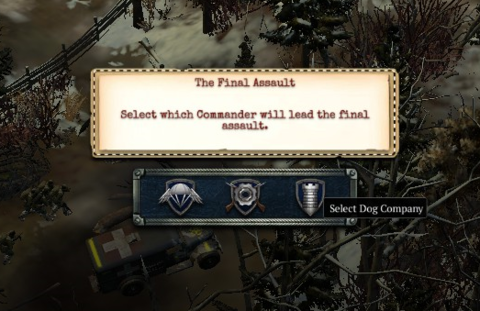
DUMB CPU-CONTROLLED ALLIES:
Making challenging CPU-controlled enemies is not easy, as mentioned earlier. However, there is less room for benefit of the doubt for failure at making competent CPU-controlled allies. Unfortunately, there will be such disappointment in this campaign, and it is worse than the already-inept CPU-controlled allies in the base campaign.
The player’s three companies are not the only USA forces around; some of the narrative-driven missions will make this clear. The problem though is that they have incompetent CPU-controlled commanders.
The worst that they would do – and this happens quite often – is that they send units against enemies that would overmatch them. This is especially noticeable because US Forces units particularly require hand-holding micromanagement to get the most out of them; the CPU-controlled allied commanders in the campaigns is just useless at this.
Perhaps the most notable failure on their part happens in the final mission. After the player has achieved the first set of hurdles, the player picks one of the three companies to “spearhead” the assault on the German bunker; this company gets to have a base. However, the other two companies do not, and whatever remaining units that the player has preserved earlier would be turned over to a CPU-controlled allied commander. This commander would then squander most of the units on a haphazard assault on the entrenched German positions.
AESTHETIC DESIGNS:
The bulk of this campaign’s visual and sound assets are derived from those in the Western Front expansion pack. Indeed, the most that the player should expect about anything that is new are the voice-overs of the company commanders and the news bulletins that play just before narrative-driven missions.
The player should not expect much from the depiction of the Ardennes. Dense copses of forests and snow have been seen before in the base-game; there are even more of them in this campaign. There are the buildings of southern France, of course, but only people who have studied colonial-era architecture could discern the details. Even then, most of them are war-blasted ruins.
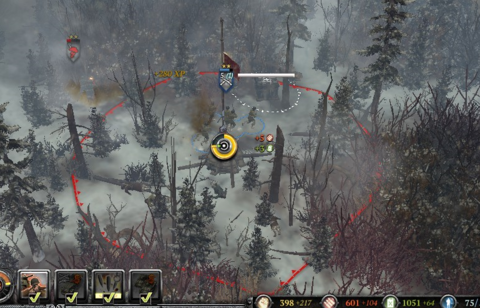
SUMMARY:
The campaign in Ardennes Assault is notably different from the one in the base game, namely having statistics to worry about throughout the campaign. The challenge of keeping casualties low is a welcome difference, though having only a single auto-save per playthrough is not as welcome.
Unfortunately, the other gameplay elements of the campaign, specifically the encounters, are dependent on luck. There are also stupid CPU-controlled allies whose incompetence that the player has to compensate for. The payoff of a presentation that is slightly better than that in the base game’s campaign might not be worth dealing with these frustrations.
